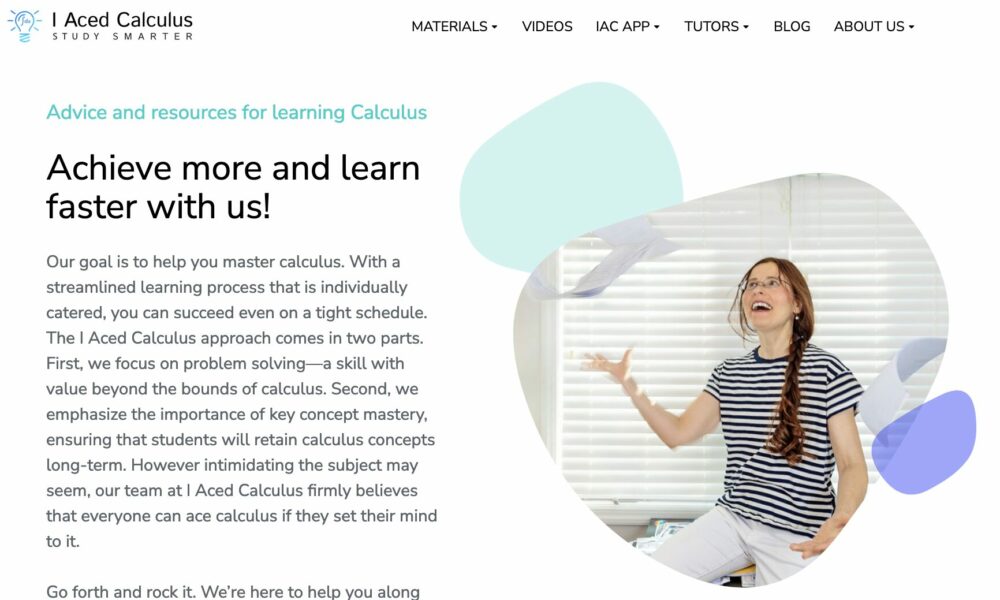Mastering the Fundamentals of Calculus for High School Students

Calculus is often introduced to students during their high school years, and for many, it can feel like a giant leap in mathematical complexity. However, it does not have to be overwhelming. By focusing on the basics, students can develop a strong foundation that will carry them through more advanced topics. Learning is all about understanding key principles and practicing regularly, which leads to mastery over time. This is especially true for calculus!
A fantastic resource to support this learning journey is I Aced Calculus. With over 400 flashcards and more than 1000 practice questions, this app offers a comprehensive approach to learning. Available on App Store, Google Play, and the web, it also includes other resources such as blogs on math topics and tutors to help you succeed.

Why High School Students Should Care About Calculus
Calculus is much more than just a requirement for passing exams. It is a powerful tool that helps explain continuous change over time. From physics to economics, the principles of calculus are applied in a variety of fields. Understanding these concepts early can open doors to higher-level studies and career paths in engineering, finance, computer science, and more.
- Calculus in Careers: Calculus is essential in many professions. Engineers, scientists, economists, and even computer scientists use calculus regularly.
- Problem-Solving Skills: Learning calculus improves critical thinking and problem-solving abilities, which are useful in all areas of life.
- Foundation for Advanced Studies: A solid understanding of calculus is crucial for more advanced topics in mathematics, physics, and engineering.
Overcoming the Initial Challenges of Calculus
For high school students, the most common roadblocks in calculus stem from unfamiliarity with new concepts like limits, derivatives, and integrals. Without sufficient practice and guidance, these topics can be confusing, but there are effective ways to learn and understand these abstract ideas.
1. Limits:
Many students struggle with understanding limits because they represent abstract concepts. A limit describes what happens as you approach a specific value, but the key is that it doesn’t always require reaching that point.
- Tip: Practice graphing functions to see how limits work visually. This helps solidify your understanding.
2. Derivatives:
Derivatives measure the rate of change of a function. In simpler terms, they tell you how fast something is changing at any given point. Once students get past the technical definitions, derivatives can be seen in everyday situations like calculating speed or growth rates.
- Tip: Work on real-life applications of derivatives, such as determining the slope of a hill or understanding the velocity of a moving object.
3. Integration:
Integration is about finding the total or accumulated quantity, such as the area under a curve or the total distance traveled. While it may seem complicated at first, breaking it down into smaller steps makes integration much easier to grasp.
- Tip: Start with simple problems and build your understanding before tackling more complicated integration problems
Effective Study Techniques for High School Calculus
To succeed in mastering calculus at the high school level, students need the right approach. Here are several strategies to ensure you are getting the most out of your study time:
1. Build a Strong Foundation
The most important step in learning calculus is ensuring you fully understand the basic concepts of algebra and geometry. Without a solid grasp of these subjects, calculus can seem almost impossible to master.
- Review key algebraic topics such as piecewise functions, exponentiation, and logarithms.
- Spend time on understanding graphing functions, as visualization is key to grasping calculus concepts like limits and derivatives.
- Review trigonometry as it often appears in calculus.
2. Practice, Practice, Practice
Consistent practice is the best way to ensure mastery of calculus. Use resources like I Aced Calculus to get access to a wide range of exercises. The flashcards and practice questions offered there help reinforce understanding through repetition.
- Even if it is only 10 minutes, set aside time every day to solve problems.
- Try to spread out your time as consistency is often the most important aspect of learning.
- Start with easier problems before progressing to more difficult ones.
3. Break Down Complex Problems
One of the keys to solving calculus problems is learning how to break them down into smaller, manageable parts. This way, even the most challenging problems become easier to handle.
- Start by making sure you understand the problem – identify what tools and concepts may be applicable or helpful.
- Focus on solving the initial steps of a problem first, such as calculating derivatives or identifying limits.
- Once you have mastered the individual components, put them together to solve the entire problem.
4. Use Online Technology
High school students today have access to technology that makes learning easier than ever. Whether it is using online graphing tools, apps, or websites like I Aced Calculus, technology can offer visual aids and instant feedback on problems.
- Take advantage of online tools to graph functions, differentiate, or integrate.
- Use practice apps to reinforce what you learn in class.
5. Seek Help When Needed
If you find yourself stuck on a particular topic or problem, don’t hesitate to ask for help. You can reach out to teachers, classmates, or even use online tutoring services offered through platforms like I Aced Calculus.
- Join study groups to collaborate with peers.
- Look for online resources such as video tutorials to explain difficult topics.
The Role of Practice Tools and Apps
With the availability of resources like I Aced Calculus, learning has become more engaging and interactive. These tools provide a practical and hands-on approach to mastering calculus concepts, helping high school students practice effectively and efficiently.
Benefits of Practice Tools:
- Interactive Learning: Engaging with flashcards and exercises keeps the mind active and reinforces learning.
- Instant Feedback: Apps provide clear and concise answers and explanations which help students to quickly learn from their mistakes.
- Structured Learning: Progress tracking allows students to keep track of their learning, ensuring they cover all the necessary topics for their exams.
Conclusion
Mastering calculus in high school is a challenge, but it is entirely achievable with the right mindset and resources. By using proper study techniques, and using online tools like I Aced Calculus, students can build a strong foundation that will benefit them in the future. With consistent practice, visualization, and access to help when needed, students will find themselves excelling in calculus, ready to take on more advanced mathematical challenges down the road.







